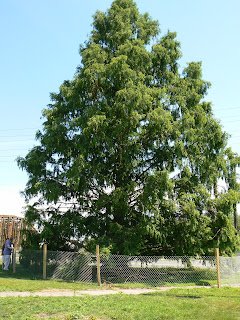I'm working for Weyerhaeuser this summer in the North Louisiana Timberlands Region. This region of the company manages nearly 750,000 acres in 22 parishes (counties) in Louisiana, 6 counties in eastern Texas, and 7 counties in southern Arkansas. There are around 53 employees and 45 logging contractors. Weyerhaeuser practices intensive forest management on even-aged stands that are mostly loblolly pine plantations. The company clearcuts around 20,000 acres a year, which they then site-prep and re-plant-- a total of nearly 9 million trees planted a year. Weyerhaeuser is also SFI certified. This region has two lumbermills and three veneer mills, with the major source of wood being supplied from company lands, followed by logs shipped in from other contractors, and then timber from private landowners.
As part of my summer internship, I have done various jobs with people of various positions in the company. So far, I have: cruised and marked timber and pulpwood on company as well as private lands; investigated disputes regarding property lines; inspected roads for BMP (best-management practices) audits; done audits on loggers for BMP work and safety equipment; located tracts and made maps on a GIS program; and compiled and checked tracts for future harvest and/or conversion.
I have worked in Louisiana and Texas so far and it is definitely a change of pace when compared to the hardwood forests of Pennsylvania. The advantage of our two-year program compared to a four-year degree is that we already have the technical training after our first year-- many people were very astonished that I knew how to cruise after only one year of school. Also, the system of mapping in Louisiana is the Section, Township, and Range, which makes it very easy to find where you need to go! I have only seen one alligator-- in the lake behind our office. I've also seen two roadrunners. But so far, I haven't seen any snakes- rattlers or mocasins- and I want to keep it that way!
The first picture is from a logging audit in east Texas. The machine behind me is a processor, which delimbs and cuts to length.

The second picture is of a longleaf pine in it's "grass stage," where it needs to be released by fire.

The third and fourth pictures are of a site prep machine that simultaneously shears rows and plows beds for planting seedlings. The beds are a pre-determined length, which is entered into a GPS receiver on the machine. This then directs the operator where to plow-- down to the foot.


The fifth picture is of me in front of a loblolly pine in Texas that is nearly 4 feet in diameter.

And last, but not least: everyone loves a log truck.

The second picture is of a longleaf pine in it's "grass stage," where it needs to be released by fire.
The third and fourth pictures are of a site prep machine that simultaneously shears rows and plows beds for planting seedlings. The beds are a pre-determined length, which is entered into a GPS receiver on the machine. This then directs the operator where to plow-- down to the foot.
The fifth picture is of me in front of a loblolly pine in Texas that is nearly 4 feet in diameter.
And last, but not least: everyone loves a log truck.



